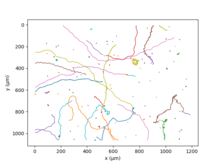Chlamydomonas reinhardtii
[1] C. reinhardtii is an especially well studied biological model organism, partly due to its ease of culturing and the ability to manipulate its genetics.
Commercially, C. reinhardtii is of interest for producing biopharmaceuticals and biofuel, as well being a valuable research tool in making hydrogen.
[7] Chlamydomonas is used as a model organism for research on fundamental questions in cell and molecular biology such as: There are many known mutants of C. reinhardtii.
These mutants are useful tools for studying a variety of biological processes, including flagellar motility, photosynthesis, and protein synthesis.
In the light, the zygote undergoes meiosis and releases four flagellated haploid cells that resume the vegetative lifecycle.
[15] The attractiveness of the algae as a model organism has recently increased with the release of several genomic resources to the public domain.
A genome-wide collection of mutants with mapped insertion sites covering most nuclear genes[24][25] is available: https://www.chlamylibrary.org/.
Repeating this elementary movement 50 times per second the algae have a mean velocity of 70 μm/s;[36] the genetic diversity of the different strains results in a huge range of values for this quantity.
The C. reinhardtii chloroplast genome can be transformed using microprojectile particle bombardment or glass bead agitation, however this last method is far less efficient.
Electroporation has been shown to be the most efficient way of introducing DNA into the nuclear genome with maximum transformation frequencies two orders of magnitude higher than obtained using glass bead method.
[citation needed] Genetically engineered C. reinhardtii has been used to produce a mammalian serum amyloid protein (needs citation), a human antibody protein (needs citation), human Vascular endothelial growth factor, a potential therapeutic Human Papillomavirus 16 vaccine,[38] a potential malaria vaccine (an edible algae vaccine),[39] and a complex designer drug that could be used to treat cancer.
[41] Triton Algae Innovations was developing a commercial alternative protein product made from C reinhardtii.
In 1939, the German researcher Hans Gaffron (1902–1979), who was at that time attached to the University of Chicago, discovered the hydrogen metabolism of unicellular green algae.
C reinhardtii and some other green algae can, under specified circumstances, stop producing oxygen and convert instead to the production of hydrogen.
Over the next thirty years, Gaffron and his team worked out the basic mechanics of this photosynthetic hydrogen production by algae.
This balance prevents the inhibition of hydrogenase activity by accumulated O2, ensuring steady hydrogen production under these optimized conditions.

